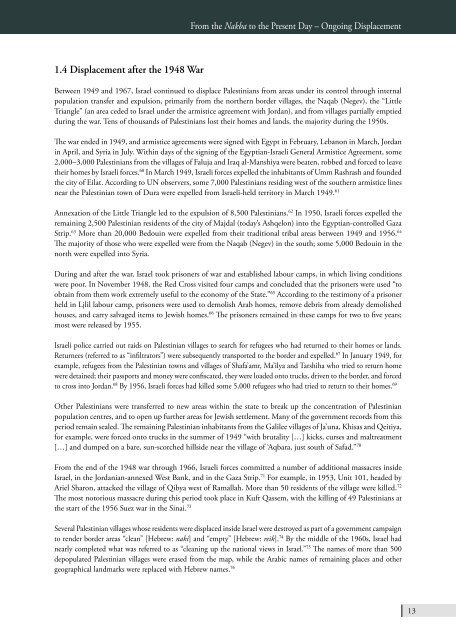BADIL Resource Center for Palestinian Residency and Refugee
BADIL Resource Center for Palestinian Residency and Refugee
BADIL Resource Center for Palestinian Residency and Refugee
You also want an ePaper? Increase the reach of your titles
YUMPU automatically turns print PDFs into web optimized ePapers that Google loves.
1.4 Displacement after the 1948 War<br />
From the Nakba to the Present Day – Ongoing Displacement<br />
Between 1949 <strong>and</strong> 1967, Israel continued to displace <strong>Palestinian</strong>s from areas under its control through internal<br />
population transfer <strong>and</strong> expulsion, primarily from the northern border villages, the Naqab (Negev), the “Little<br />
Triangle” (an area ceded to Israel under the armistice agreement with Jordan), <strong>and</strong> from villages partially emptied<br />
during the war. Tens of thous<strong>and</strong>s of <strong>Palestinian</strong>s lost their homes <strong>and</strong> l<strong>and</strong>s, the majority during the 1950s.<br />
The war ended in 1949, <strong>and</strong> armistice agreements were signed with Egypt in February, Lebanon in March, Jordan<br />
in April, <strong>and</strong> Syria in July. Within days of the signing of the Egyptian-Israeli General Armistice Agreement, some<br />
2,000–3,000 <strong>Palestinian</strong>s from the villages of Faluja <strong>and</strong> Iraq al-Manshiya were beaten, robbed <strong>and</strong> <strong>for</strong>ced to leave<br />
their homes by Israeli <strong>for</strong>ces. 60 In March 1949, Israeli <strong>for</strong>ces expelled the inhabitants of Umm Rashrash <strong>and</strong> founded<br />
the city of Eilat. According to UN observers, some 7,000 <strong>Palestinian</strong>s residing west of the southern armistice lines<br />
near the <strong>Palestinian</strong> town of Dura were expelled from Israeli-held territory in March 1949. 61<br />
Annexation of the Little Triangle led to the expulsion of 8,500 <strong>Palestinian</strong>s. 62 In 1950, Israeli <strong>for</strong>ces expelled the<br />
remaining 2,500 <strong>Palestinian</strong> residents of the city of Majdal (today’s Ashqelon) into the Egyptian-controlled Gaza<br />
Strip. 63 More than 20,000 Bedouin were expelled from their traditional tribal areas between 1949 <strong>and</strong> 1956. 64<br />
The majority of those who were expelled were from the Naqab (Negev) in the south; some 5,000 Bedouin in the<br />
north were expelled into Syria.<br />
During <strong>and</strong> after the war, Israel took prisoners of war <strong>and</strong> established labour camps, in which living conditions<br />
were poor. In November 1948, the Red Cross visited four camps <strong>and</strong> concluded that the prisoners were used “to<br />
obtain from them work extremely useful to the economy of the State.” 65 According to the testimony of a prisoner<br />
held in Ljlil labour camp, prisoners were used to demolish Arab homes, remove debris from already demolished<br />
houses, <strong>and</strong> carry salvaged items to Jewish homes. 66 The prisoners remained in these camps <strong>for</strong> two to five years;<br />
most were released by 1955.<br />
Israeli police carried out raids on <strong>Palestinian</strong> villages to search <strong>for</strong> refugees who had returned to their homes or l<strong>and</strong>s.<br />
Returnees (referred to as “infiltrators”) were subsequently transported to the border <strong>and</strong> expelled. 67 In January 1949, <strong>for</strong><br />
example, refugees from the <strong>Palestinian</strong> towns <strong>and</strong> villages of Shafa’amr, Ma’ilya <strong>and</strong> Tarshiha who tried to return home<br />
were detained; their passports <strong>and</strong> money were confiscated, they were loaded onto trucks, driven to the border, <strong>and</strong> <strong>for</strong>ced<br />
to cross into Jordan. 68 By 1956, Israeli <strong>for</strong>ces had killed some 5,000 refugees who had tried to return to their homes. 69<br />
Other <strong>Palestinian</strong>s were transferred to new areas within the state to break up the concentration of <strong>Palestinian</strong><br />
population centres, <strong>and</strong> to open up further areas <strong>for</strong> Jewish settlement. Many of the government records from this<br />
period remain sealed. The remaining <strong>Palestinian</strong> inhabitants from the Galilee villages of Ja’una, Khisas <strong>and</strong> Qeitiya,<br />
<strong>for</strong> example, were <strong>for</strong>ced onto trucks in the summer of 1949 “with brutality […] kicks, curses <strong>and</strong> maltreatment<br />
[…] <strong>and</strong> dumped on a bare, sun-scorched hillside near the village of ‘Aqbara, just south of Safad.” 70<br />
From the end of the 1948 war through 1966, Israeli <strong>for</strong>ces committed a number of additional massacres inside<br />
Israel, in the Jordanian-annexed West Bank, <strong>and</strong> in the Gaza Strip. 71 For example, in 1953, Unit 101, headed by<br />
Ariel Sharon, attacked the village of Qibya west of Ramallah. More than 50 residents of the village were killed. 72<br />
The most notorious massacre during this period took place in Kufr Qassem, with the killing of 49 <strong>Palestinian</strong>s at<br />
the start of the 1956 Suez war in the Sinai. 73<br />
Several <strong>Palestinian</strong> villages whose residents were displaced inside Israel were destroyed as part of a government campaign<br />
to render border areas “clean” [Hebrew: naki] <strong>and</strong> “empty” [Hebrew: reik]. 74 By the middle of the 1960s, Israel had<br />
nearly completed what was referred to as “cleaning up the national views in Israel.” 75 The names of more than 500<br />
depopulated <strong>Palestinian</strong> villages were erased from the map, while the Arabic names of remaining places <strong>and</strong> other<br />
geographical l<strong>and</strong>marks were replaced with Hebrew names. 76<br />
13

















